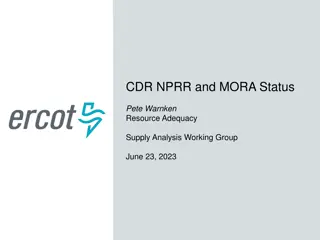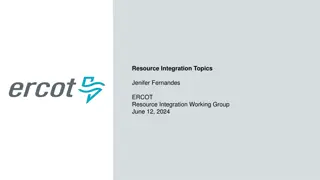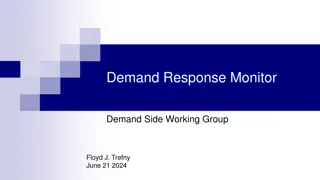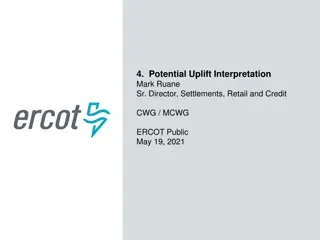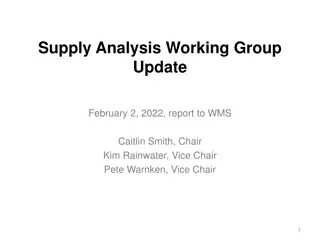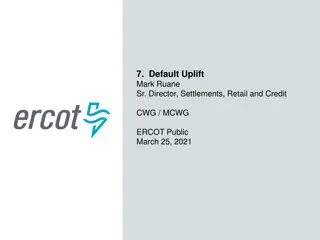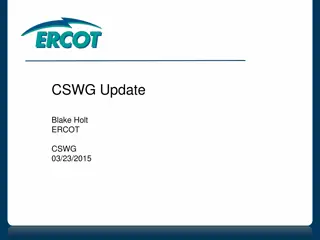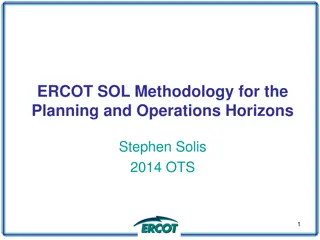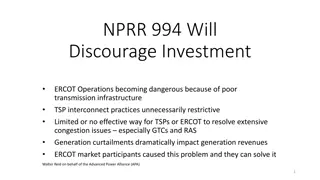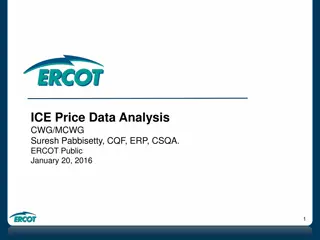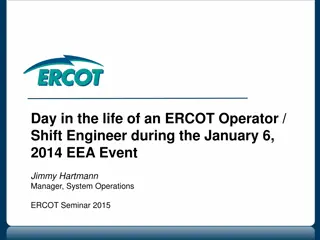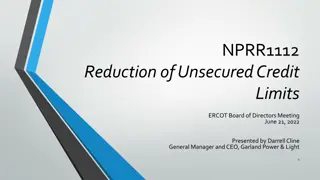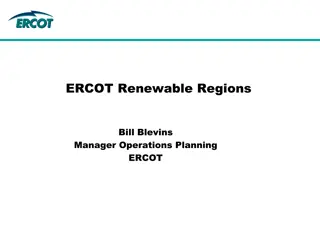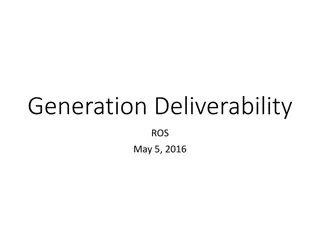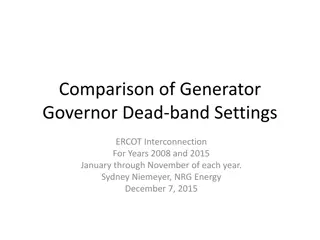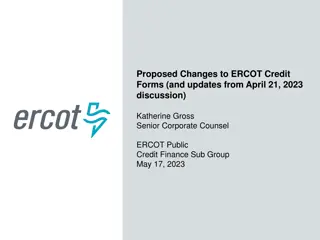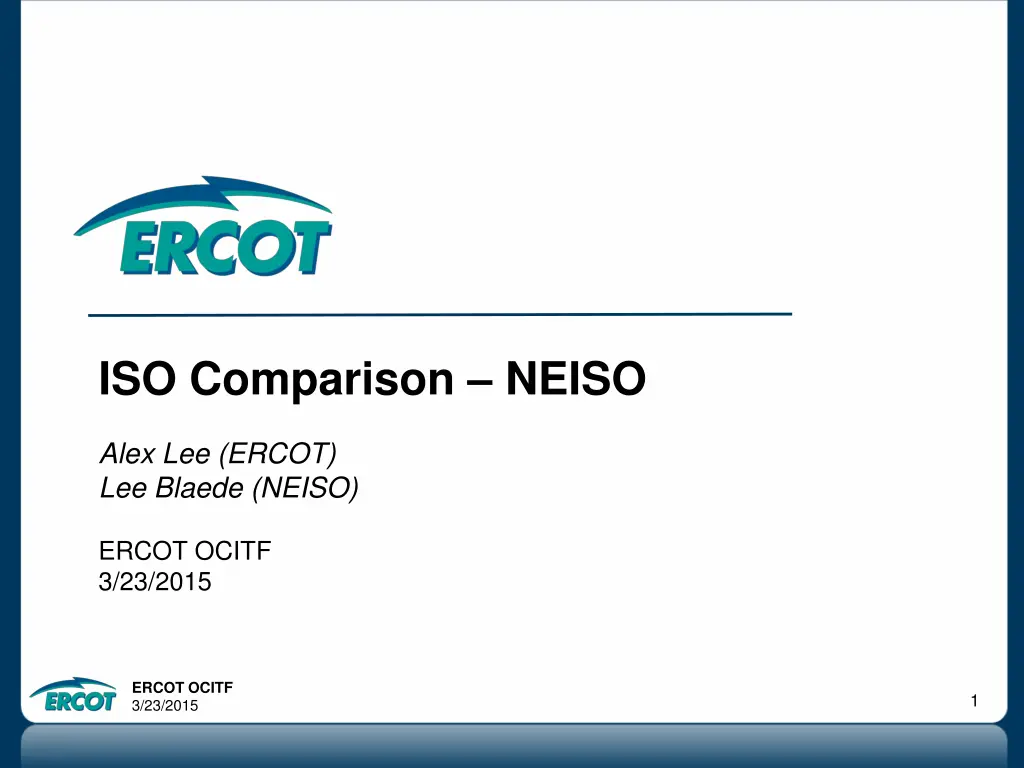
Transmission Outage Management Insights - ERCOT vs NEISO Comparison
Explore the comparison between ERCOT and NEISO in terms of generators, peak demand, transmission infrastructure, outage coordination timelines, and planned outage patterns. Gain valuable insights into how these ISOs manage transmission outages effectively.
Download Presentation

Please find below an Image/Link to download the presentation.
The content on the website is provided AS IS for your information and personal use only. It may not be sold, licensed, or shared on other websites without obtaining consent from the author. If you encounter any issues during the download, it is possible that the publisher has removed the file from their server.
You are allowed to download the files provided on this website for personal or commercial use, subject to the condition that they are used lawfully. All files are the property of their respective owners.
The content on the website is provided AS IS for your information and personal use only. It may not be sold, licensed, or shared on other websites without obtaining consent from the author.
E N D
Presentation Transcript
ISO Comparison NEISO Alex Lee (ERCOT) Lee Blaede (NEISO) ERCOT OCITF 3/23/2015 ERCOT OCITF 3/23/2015 1
ERCOT vs NEISO High Level Overview 550 generators 68 GW summer peak demand 74 GW generating capacity Annual Ave. Spot Price $42/MWh (2014) 6,500 bus 43,000 miles transmission lines (69kV+) 350 generators 28 GW summer peak demand 31 GW generating capacity Annual Ave. Spot Price $82/MWh (2014) 900 bus 8,500 miles transmission lines (115kV+) TX ERCOT OCITF 3/23/2015 2
Outage Coordination Process Timelines - Transmission PLAN START ERCOT 90 45 9 4 3 4 3 90 45 (Mid Term) 9 (Mid Term) Forced 75 30 4 3 2 Approval Deadline NEISO 21 5 Long Term Short Term Unplanned 10 days after receipt 1 Approval Deadline Note: All numbers are in days. ERCOT OCITF 3/23/2015 3
Planned Transmission Outage Submittal Pattern 2012 Total Planned Transmission Outages ERCOT 74,785 equipment (7,903 groups and 4,462 ungrouped equipment) NEISO 3,495 groups ERCOT OCITF 3/23/2015 Note: Numbers includes only planned-type transmission outages which start each year. 4
Planned Transmission Outage Cancellation Trend ERCOT OCITF 3/23/2015 Note: Numbers includes only planned-type transmission outages which start each year. 5
Outage Coordination Process Timelines - Resource PLAN START ERCOT 45 9 4 3 4 3 45 9 Forced Automatically Accepted 5 business day after receipt; otherwise, automatically accepted Approval Deadline NEISO 15 Planned Unplanned Requested at least 7 days in advance, process within 3 days. Requested less than 7 days in advance, process within 1 day. 3 days after receipt Approval Deadline ERCOT OCITF 3/23/2015 Note: All numbers are in days. 6
Planned Resource Outage ERCOT OCITF 3/23/2015 Note: Numbers includes only planned-type transmission outages which starts each year. 7
Additional Resource Outage Types ISO Failure to Start AVR PSS Unit Test EROCT NEISO RT RT RT OS OS OS RT = Handled in Real-Time. OS = Requires Outage Submission. NEISO s AVR and PSS outage submissions are for tracking purpose only. Outage Coordination does not implement analysis to approve or deny. Knowing future planned unit testing schedules could slightly improve accuracy of the forward economic analysis. ERCOT OCITF 3/23/2015 8
Outage Coordination Analysis Analysis Powerflow & Contingency Yes Yes Dynamic Studies Need-based Need-based Economic Analysis ERCOT NEISO High Impact Outages Need-based Power-flow and contingency analysis are performed daily prior to each outage s approval deadline. Dynamic studies are performed when outages affecting interfaces are requested. NEISO performs economic analysis when potentially costly outages are requested. ERCOT OCITF 3/23/2015 9
NEISO Economic Outage Evaluation History 2003 Observed high congestion over years and identified opportunities in rescheduling transmission outages to reduce congestion. 2005 Authorized to deny transmission outage which costs $200,000 or more per week. Utilized existing Day Ahead market software. Slow (45 minute), inflexible, and single-day only. Manually enter real-time bids and offers Easily takes full day to perform single analysis. 2008 Chose PowerGEM PROBE market simulator. Fast (1 minute), flexible, and multiple-days. Bid Production Cost Analysis. 2010/2011 Completed OCEAT (Outage Coordination Economic Analysis Tool) based on PROBE and started to fully utilize the tool. ERCOT OCITF 3/23/2015 10
NEISO: Bid Production Cost Analysis Captures: Reliability-committed generation incremental costs, startup costs, and no-load costs. Expensive units dispatched out-of-merit due to transmission constraints caused by outages. Generation cost-savings of units displaced by reliability commitments. Potentially misses the high congestion rent with insignificant production cost difference. ERCOT OCITF 3/23/2015 11
NEISO: Economic Outage Evaluation Process Flow PLAN START 90 5 Short-Term Economic Analysis Long-Term Economic Analysis At Risk for Economics in Short-Term Process Approved or Denied Interim Approved or Reposition 3-5 days before plan start Provides relative certainty to proceed outage as scheduled. Identify and coordinate expensive or conflicting outages Provides confidence in selecting the outage for monthly FTR and FCM reconfiguration auctions. Generally does not consider repositioning outages with long-term economic approval or taken in FTR auction ERCOT OCITF 3/23/2015 12
NEISO Economic Outage Evaluation ERCOT OCITF 3/23/2015 13
Staff Comparison ERCOT Outage Coordination NEISO ERCOT OCITF 3/23/2015 14


